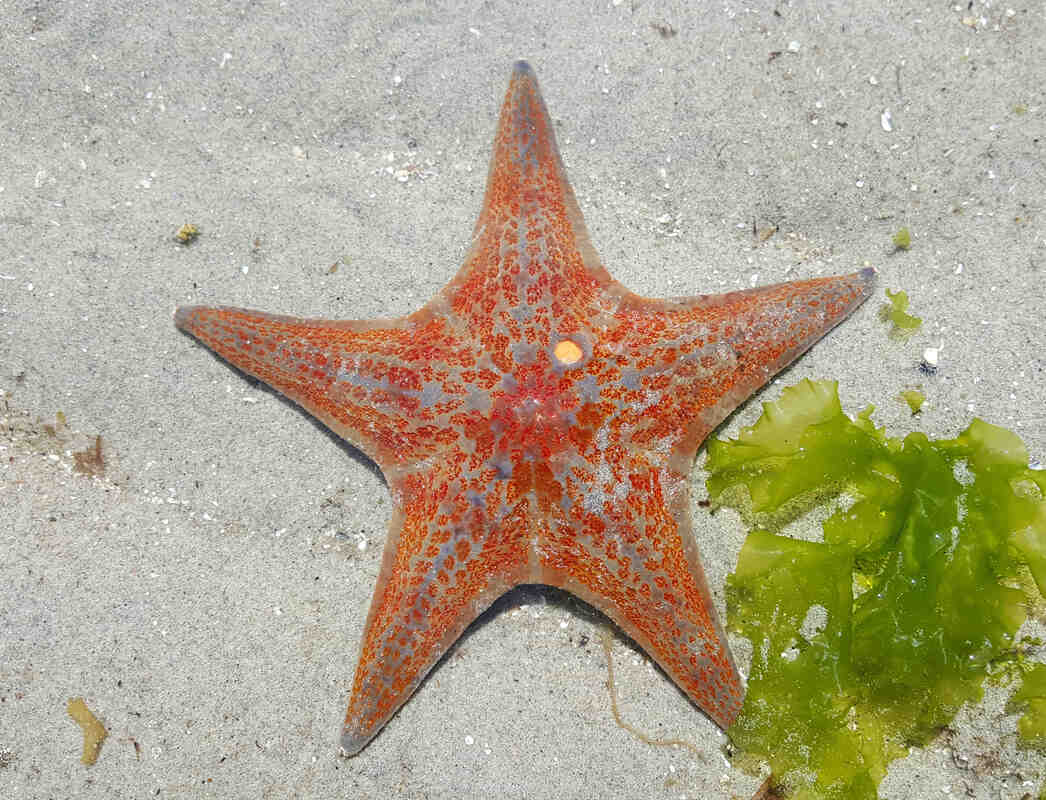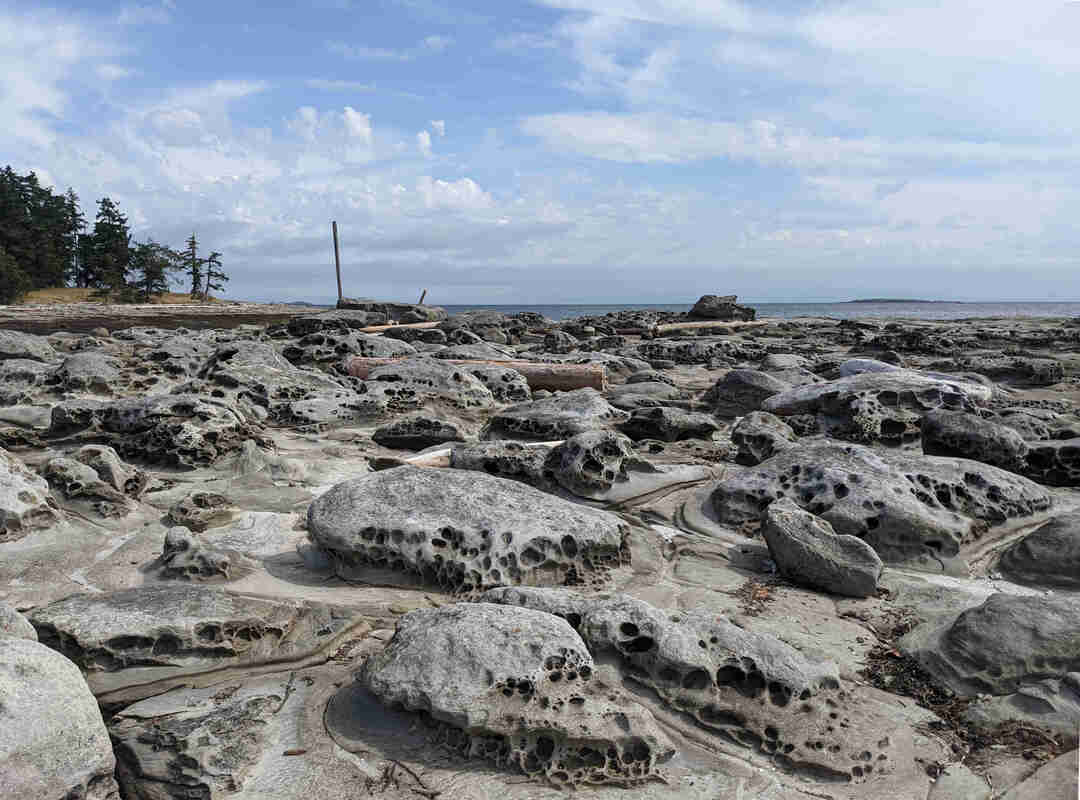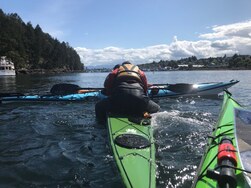|
In July alone we spotted the blonde raccoon on Saysutshun 4 times. It might be the same one or there might be more than one blonde raccoon on the island, we don't know. This phenomenon is the same as the spirit bear up north. The raccoon is not albino (lacking the red eyes) but it is a recessive gene that seems to be more common on Saysutshun than many other places. The striking colouring occurs when two adults mate that don't carry the gene responsible for the production of black pigment; 25% of the time, those parents produce blond offspring. Pretty much the same as humans having the recessive gene for blue eyes.
Other than their colour the raccoon behaves and interacts pretty much the same as any other raccoons. She(?) even seems to have normal coloured offspring. We mostly spot the blond raccoon at a low tide on the NW side of the island at Saltery Beach. Quite the local celebrity!!!
1 Comment
On April 29 we had a very calm ocean and a low tide as well. We encountered many sea stars (mainly Ochre and Leather Stars) but also the Giant Plumose Anemone (Metridium farcimen). It is really weird to see them above the waterline; they appear to be hanging balloons full of water. Under the water they form a nice umbrella with many tentacles. Did you know they only have one digestive system; the mouth is also the anus! The tentacles are festooned with millions of cells called cnidocytes, each of which has a tiny, harpoon-like mechanism. Prey capture is a common function of these specialized cells, many of which contain an associated toxin.
The body type of the anemone is called the polyp where there is a ring of tentacles and mouth/anus configuration atop of a columnar body. Cnidarians can also have the medusa type, where the layout is hanging down and free-floating, a jelly is a great example of this. If you do not have a kayak and you would like to see them up close: check the underside of the docks in the Nanaimo marina's. I bet you will spot them there as well!!  We are getting closer to the solstice and the tidal differences are getting bigger. Our kayak tours are sometimes at a low tide and then we see a lot of sea stars (or starfish but biologists like to call them sea stars ;-) ). The most common sea stars in the Nanaimo area are the Ochre Sea Star (Pisaster ochraceus) and the Leather Star (Dermasterias imbricata). The Ochre Sea Star is purple or orange and feels very tough, almost like a rock. The Leather Star is orange and feels like soft leather. Both species almost disappeared in 2013 due to the Sea Star Wasting Syndrome and is possibly caused by a single-stranded DNA-virus and/or environmental changes like the warming of the ocean, i.e., still not fully understood. Luckily the Ochre Sea Star and the Leather Star bounced back relatively quickly but some sea stars like the Sunflower Sea Star (Pycnopodia helianthoides, with 16 to 24 limbs!) which eat the Ochre Sea Star is still not seen in the Nanaimo waters. During our tours we explain how the sea stars live, move and eat. It is always great to see them sometimes in big clusters hanging from the rock walls.  Recently, we had an amazing encounter with a river otter in the Nanaimo Channel. While we were following the Saysutshun/Newcastle Island shore suddenly a river otter popped up with a crab in her mouth. The crab was still alive and the otter managed to bring it to shore. Then the otter started eating the crab right in front of our kayaks, not even meters away. Northern River Otters (Lontra Canadensis; the weasel family) are a common sight on kayak tours in Nanaimo and can be found year-round mostly when the tide is low or close to dusk. With their streamlined bodies, rudderlike tails, webbed toes and valved ears and nostrils, river otters are well adapted for aquatic habitats including the BC coastline. They love to play as well, are social animals, and they frolic together in the water and take turns sliding down banks. The large amounts of playtime they seem to have results from their efficiency at catching prey when it is plentiful. And on the coast there is enough crabs and fish around. Otters can hold their breath for as long as five minutes and can sprint after their prey with the ease of a seal. When an otter swims quickly, it propels itself mainly with vertical undulations of its body, hindlegs and tail. River otters leave many signs of their presence; the most noticeable are their sliding trails and their scat. Otters always defecate on land and scat is always full of crab scales and fish bones; we see lots of these smelly examples on the nearby docks and floats. Do not mistake the river otter for a sea otter! River otters are smaller and also like to spend some time on land while the sea otter hardly ever goes to shore. Both otter species were almost hunted to extension due to their thick, beautiful, durable fur pelt. It is always great to see a Northern River Otter while kayaking and they never seem to be intimidated by our presence. Enjoy the video of our encounter! Saysutshun / Newcastle Island is completely made of sandstone; they even had sandstone quarries on the island. Around the tide line salt water penetrates into the sandstone and when the sun is warming the rocks this water wants to evaporate. At the surface it then forms salt crystals which chip off pieces of sand and forming these funky, weird honeycomb and wave-like patterns. The sandstone formation in Kanaka Bay is particularly beautifully eroded and the landscape almost looks alien. At high tide these rocks completely disappear under water so you can imagine how much salt water will penetrate into the sandstone again and again repeating the process of erosion.
With this heat wave it is great to go for an evening paddle; the ocean breeze is nice and refreshing and you can go for a swim afterwards ;-)
The coming days it is going to be an extreme low tide in Nanaimo. Last time we were out at such a low tide we saw anemones, tons of seastars and many shapes of seaweeds. It is definitely something special to check out and we encourage you to go to a local beach, grab a kayak or canoe or book a kayak tour and see how different Departure Bay and Kanaka Bay can be. Low tides the coming days: - Thursday (June 24) at 11:56 am a 0.0 m tide - Friday (June 25) at 12:43 pm a 0.0 m tide - Saturday (June 26) at 13:30 pm a 0.1 m tide - Sunday (June 27) at 14:16 pm a 0.3 m tide Go out there and be amazed!!!! Last weekend on our kayak course we completed a new assisted kayak rescue, the Covid Rescue. Here is how we rescued a swimmer and still stayed at a distance:
|
AuthorRichard Römer likes to roam around on Vancouver Island and creates exceptional adventures on Vancouver Island, the Sunshine Coast, Discovery Islands in British Columbia, Canada Archives
July 2022
Categories |

















 RSS Feed
RSS Feed
